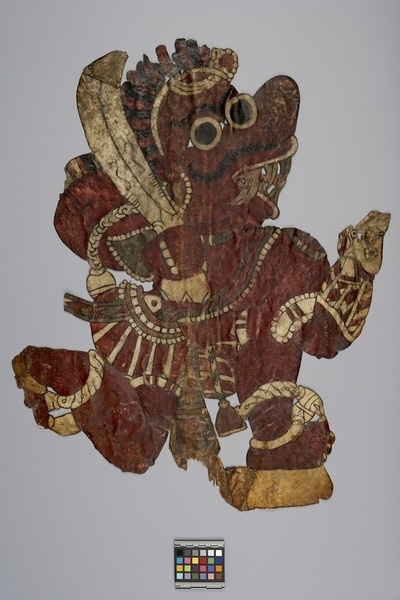Shadow Puppet Item Number: Ef222 from the MOA: University of British Columbia

Description
A shadow puppet, representing the character Rakshasa (night wanderer). Made of leather cut out and depicts a part human-part monster with two large black circular eyes and fangs. Dyed mostly red with green and black. Holding a sword in its left hand. Its right hand is missing from the other outstretched arm, as is the left foot of the raised leg. Wearing chain link jewelry. Long hair is partly broken off.
History Of Use
Puppetry, particularly shadow puppetry, is an ancient dramatic form in India mentioned in the Buddhist Jataka Tales of the 3rd century B.C.E. Nowadays modern forms of entertainment, such as the Hindi film industry, have rendered them extinct except for some rural areas in the states of Orissa, Kerala, Andhra Pradesh, and Tamil Nadu. The Andhra Pradesh/Karnataka shadow puppet tradition, compared to the few remaining troupes, are the most extensive and dramatic. Probably originally Maharashtran and maintained by dynasties, such as the Vijaynagars of the 13th and 14th centuries, it now survives as presented by Marathi-speaking puppeteers, commonly called Raoji. These are the largest in size of the Indian shadow puppets.
Iconographic Meaning
Represents a rakshasa, a 'night wanderer', many of which comprise the army of Ravanna, king of the rakshasa. These fearful beings can take many forms, animal, human, or monster, and may even appear beautiful. They have big noses, sharp teeth, a moustache and large belly.
Item History
- Made in Andhra Pradesh, India between 1880 and 1930
- Collected during 1976
- Owned by Tirukodur Ramamurthy
- Owned by Stephen Inglis before December 2, 1977
- Received from Museum of Anthropology Donations Fund (Funding source) and Stephen Inglis (Seller) on December 2, 1977
What
Who
- Culture
- South India
- Previous Owner
- Tirukodur Ramamurthy and Stephen Inglis
- Received from
- Museum of Anthropology Donations Fund (Funding source) and Stephen Inglis (Seller)
Where
- Holding Institution
- MOA: University of British Columbia
- Made in
- Andhra Pradesh, India
When
- Creation Date
- between 1880 and 1930
- Collection Date
- during 1976
- Ownership Date
- before December 2, 1977
- Acquisition Date
- on December 2, 1977
Other
- Condition
- fair
- Accession Number
- 0411/0229